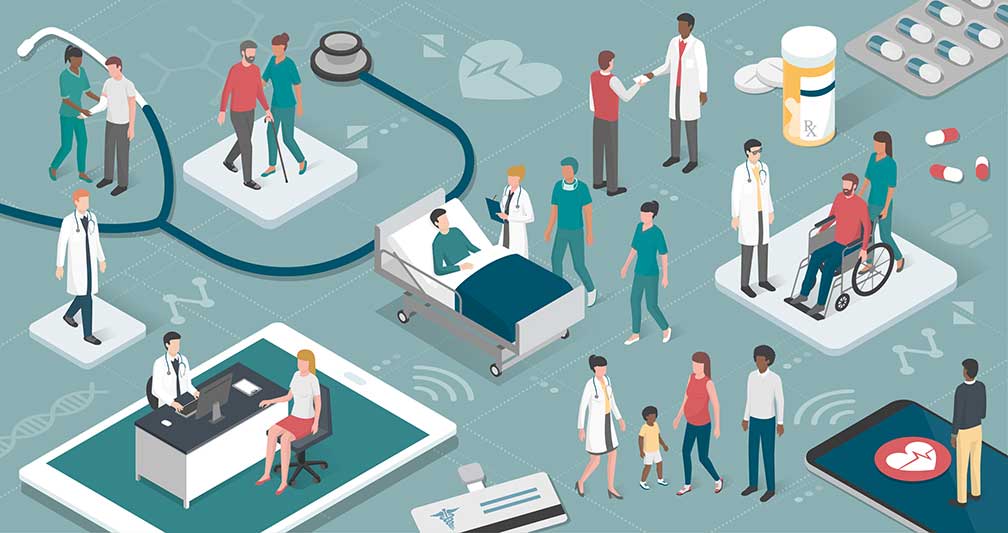We all know the healthcare industry has been slower than other industries when it comes to innovation. Whether it’s because of razor-thin (or negative) margins, government regulations, the complexity of the system, or just a general hesitancy to innovate when lives are on the line, healthcare has lagged behind in implementing new technology.
This topic was front at center at the American College of Healthcare Executives (ACHE) Congress, held in Chicago, March 4-7. The event, attended by senior healthcare leaders, focused on new technologies, how leaders should think about innovation, and how health systems need to focus on the consumer (not the patient). Here’s a look.
Having an innovation mindset
ACHE Congress kicked off the opening session with Josh Linkner, an expert on creativity, entrepreneurship, and disruptive innovation. Linkner talked about the dizzying rate of speed at which technological change is happening, and how leaders can be surprisingly creative in the context of administering healthcare.
Linkner shared with attendees his 5 core mindsets of innovators. They are:
- Every barrier can be penetrated. Instead of thinking, “We can’t do anything,” leaders should think about how things could be done differently.
- Video killed the radio star. Children of the late ‘70s/early ‘80s might remember this video, which was the first to play on MTV in 1981. Innovators who follow this rule let go of the past in favor of what’s possible, embracing new trends and approaches.
- Break the rules to get the jewels. In healthcare, resources are often constrained. However, Linkner believes this can be a benefit. He talked about how creativity can soar when budgets are tight because you have to figure out new ways to get the job done.
- Seek the unexpected. When there are seemingly Options A, B, and C, don’t just pick one. Come up with your Option X – the bold idea. For children’s hospitals, this could be taking a mundane task such as washing windows, and turning it into an experience to brighten the day of sick children, as shown in the video below.
- Fall seven times, stand eight. This is all about how we come back from adversity. Are we going to let our failures destroy us, or are we going to learn from them and stand back up?
The future of health and medicine
Linkner got everyone into an innovation mindset, but what do you do with that? What are some of the technologies that can disrupt healthcare? Daniel Kraft, chair of medicine and neuroscience at Singularity University, spoke to attendees about a mind-dizzying array of innovations that could change the market.
Kraft talked about the “Uber-ization” of healthcare and how healthcare providers need to think outside the box instead of just trying to deliver incremental improvements on the same product, which was what Kodak did before it was pushed out of business.
Bachmeyer Memorial Address Speaker @daniel_kraft on new technologies in healthcare: “We all want to be the disrupters, not the disruptees.” #ACHECongress pic.twitter.com/AN1x6LoEEw
— ACHE (@ACHEConnect) March 4, 2019
A few of the more interesting technologies Kraft discussed:
- Ways to gather more information on patients that they can use to improve their health. We are already seeing this with wearables. However, this could also include “insideables” – embedded chips that contain medical information, as well as other apps to gather data on things like behavioral changes that could affect health. He talked about the potential of how all this data could be used to create a “FICO score for our health” or on “OnStar for the human body” that would alert us when things are going wrong.
- Tools to augment clinicians, such as virtual reality or Google Glass for the operating room.
- Now that the price of genome sequencing has dropped, pharma could orient itself more towards precision medicine and personalized treatments for patients.
A couple of points Kraft made during his discussion. First, a lot of data right now is siloed, and for healthcare to innovate, this data will have to be tied together and be able to easily be shared. Second, a lot of people talk about artificial intelligence as a replacement of humans, but Kraft doesn’t see it that way. His hope is that the future will blend what machines do well with what humans do well.
The future of healthcare is not one technology, but how they overlap and converge. @daniel_kraft #ACHECongress
— Kathy Sucich (@ksucich) March 4, 2019
The patient vs. the consumer
A lot of the discussions at ACHE Congress focused on the increasing voice of the healthcare consumer and how health systems need to keep them top of mind as they are innovating. This point was driven home by Ryan Donohue of National Research Corporation in his “Hot Topic” session titled, “The Curious Case of Healthcare Consumers and the Impact on Decisions and Cost.”
Donohue purposely used the word “consumer” instead of “patient” because healthcare organizations need to treat people as consumers and not just think of them when they are sick. Donohue says health systems have done a terrible job of communicating their benefit to consumers.
Hot Topic Session: The Curious Case of Healthcare Consumers and the Impact on Decisions and Cost with @RyanDDonohue #ACHECongress pic.twitter.com/qlEEV01z5s
— Lindsey Lehman, MPH, MHA (@lmlehman_health) March 6, 2019
#Healthcare consumers are mostly confused as to how to navigate the healthcare continuum which negatively impacts their experience. How can we help them navigate? @NRCHealth #ACHECongress
— Dr. Bob Dent (@bobdent) March 6, 2019
What do consumers want in their healthcare experience?
- More options for care, and they want it off-site.
- Better access to care. This is no longer about scheduling, capacity, or referrals, but is more about having digital options. Donohue shared a surprising stat, which was that 38% of consumers indicated they would go to Walmart for an MRI. When asked why, they said, “I know where Walmart is and I know they have low prices.”
- Not just lower costs of care, but more predictable costs of care. Out of pocket costs are increasing, and healthcare costs are too opaque right now.
Consumers now the fastest-growing payer of #healthcare services. —> “Healthcare had better start acting like I’m paying for it.” @RyanDDonohue #ACHECongress
— Kathy Sucich (@ksucich) March 6, 2019
Donahue argued that more healthcare providers should think like Amazon. During meetings, Amazon executives place an empty chair at the head of the table, which signifies the consumer. Imagine the consumer sitting in that chair. What would that person say? What would he or she want from a healthcare experience?
Final takeaways
Of course, these sessions that I touched on were just a small part of the ACHE Congress agenda. I attended many other sessions on patient engagement, artificial intelligence, and an inspiring breakfast on women in healthcare leadership.
One strong piece of advice I received was from Linkner’s opening session in which he discussed creativity. He talked about how leaving a conference such as this one can often feel so overwhelming that you don’t know where to begin to start to enact change. So his piece of advice was: in the next seven days, seek one creative disruption in your work. If you could innovate in just one place this week, where would it be?
Related articles
- HIMSS19: Seeing Real Results from Healthcare Technology
- 3 Predictions for Healthcare Technology in 2019
- Why Interoperability is Paramount in the New Healthcare Landscape
Ready for a test drive of our healthcare analytics software?
- Navigating the Future: Trends in Wine Tasting Rooms - July 16, 2024
- Why You’ll Want to Attend DIUC24 - June 20, 2024
- The Role of Technology in Solving Nursing Challenges - May 6, 2024



